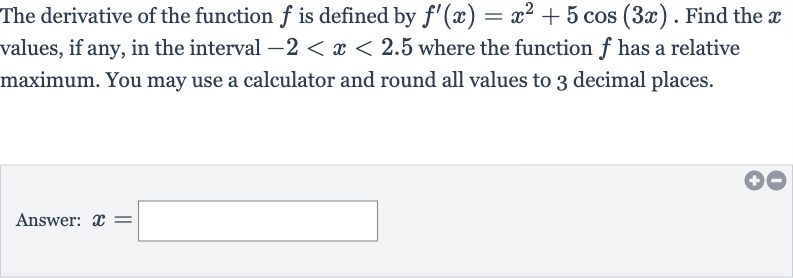Full solution
Q. The derivative of the function is defined by . Find the values, if any, in the interval where the function has a relative maximum. You may use a calculator and round all values to decimal places.Answer:
- Find Critical Points: To find the relative maximum of the function , we need to find the critical points of in the given interval. Critical points occur where the derivative is zero or undefined.
- Set Derivative Equal: First, we set the derivative equal to zero to find potential critical points:
- Solve for : We solve for using a calculator, as the equation involves both polynomial and trigonometric terms:
- Use Calculator: Since the equation is transcendental and cannot be solved algebraically, we use numerical methods or a graphing calculator to find the approximate values of in the interval -2 < x < 2.5.
- Determine Maxima: After using a calculator, we find that the approximate values of that satisfy the equation are , , and (rounded to three decimal places).
- Apply First Derivative Test: Next, we need to determine which of these critical points are relative maxima. To do this, we can use the first derivative test, which involves checking the sign of the derivative before and after each critical point.
- Check Sign Change: We plug in values slightly less and slightly more than , , and into the derivative to check the sign change.
- Relative Maximums: For , we find that the derivative changes from positive to negative, indicating a relative maximum at this point.
- Relative Maximums: For , we find that the derivative changes from positive to negative, indicating a relative maximum at this point.For , we find that the derivative changes from negative to positive, indicating a relative minimum at this point, so we discard it.
- Relative Maximums: For , we find that the derivative changes from positive to negative, indicating a relative maximum at this point.For , we find that the derivative changes from negative to positive, indicating a relative minimum at this point, so we discard it.For , we find that the derivative changes from positive to negative, indicating a relative maximum at this point.
- Relative Maximums: For , we find that the derivative changes from positive to negative, indicating a relative maximum at this point.For , we find that the derivative changes from negative to positive, indicating a relative minimum at this point, so we discard it.For , we find that the derivative changes from positive to negative, indicating a relative maximum at this point.Therefore, the function has relative maxima at and within the interval -2 < x < 2.5.

